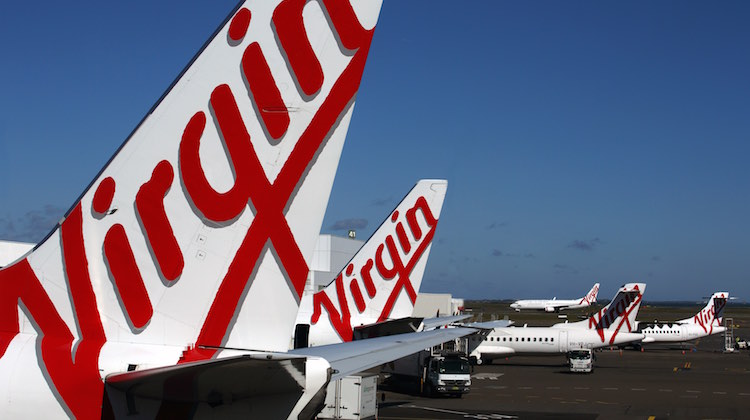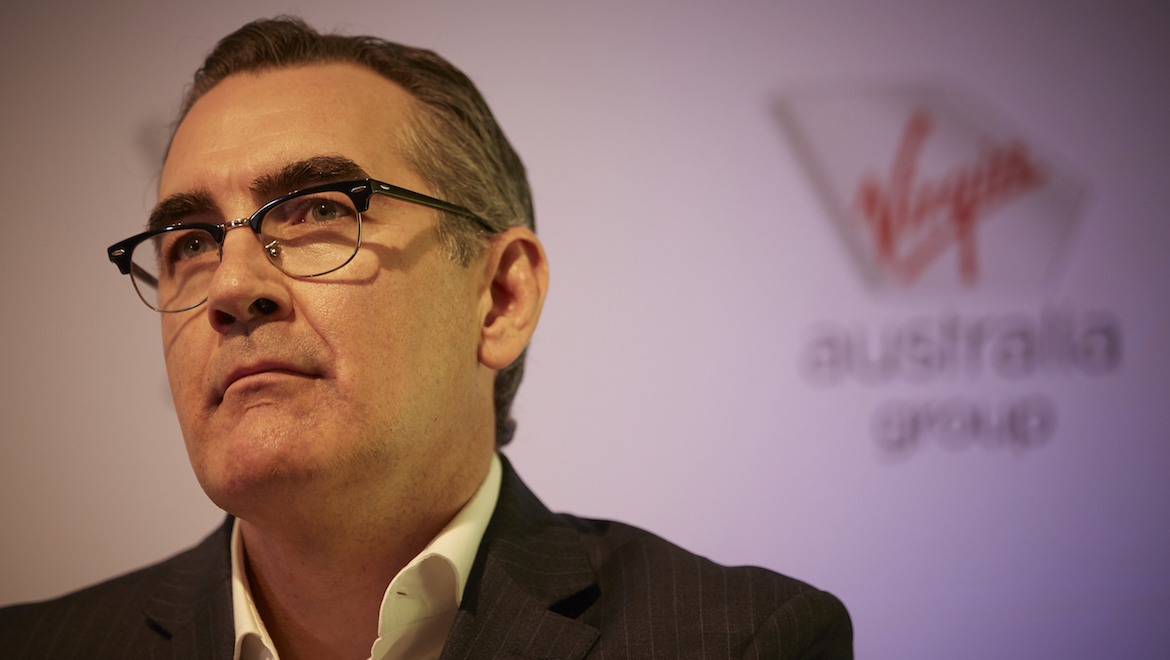
Virgin Australia says it plans to cut costs, trim capacity across its domestic and international network and overhaul its management structure after slumping to a $349.1 million net loss in 2018/19.
While the result for the 12 months to June 30 2019 was an improvement from the $681 million net loss in the prior year, it represented Virgin Australia’s seventh consecutive annual loss.
Revenue rose 7.5 per cent to $5.83 billion, Virgin Australia said in a regulatory filing to the Australian Securities Exchange on Wednesday.
Virgin Australia chief executive Paul Scurrah, handing down his first set of annual results since starting at the airline in March 2019, said it was a disappointing result.
“There is no doubt that we are operating in a tough economic climate with high fuel, a low Australian dollar, and subdued trading conditions,” Scurrah said in a statement.
“However, today’s results show that we must improve our financial performance. While we have continued to grow revenue and have a strong loyal customer base, we need to make changes to our costs to ensure we see financial benefit from the growth in our business.”
The airline group’s total fuel bill rose by $158.8 million in 2018/19.
Meanwhile, cost per available seat kilometre (CASK) across the airline group, excluding fuel and foreign exchange, rose by four per cent in 2018/19.

Management changes, staff losses
Virgin Australia said it expected to cut about 750 corporate and head office roles during the current financial year. There will also be a management restructure to reduce duplication across the business.
These changes were expected to result in cost savings of $75 million and be cash flow positive for the airline group in 2019/20.
“Regarding the reduction of our workforce, I am acutely aware of the impact this has on our team members,” Scurrah said.
“However, if we are to position the business for the future, create new opportunities, improve competitiveness, and continue to deliver for our customers, we need to make tough but important decisions that are in the long-term interests of the group.”
In addition to these short-term measures, Scurrah said there was more work needed on the “long-term focus and positioning of the business”.
“We will be focused on being the best value airline for both the corporate and leisure traveller, offering the strong and unique Virgin experience and proposition that we know will appeal to all market segments,” Scurrah said.
“As I’ve said previously, key to our success is ensuring we strike the right balance between the interests of our team members, customers and our shareholders. We’ll be focused on delivering for all three groups.”
Virgin Australia said it was conducting a detailed review of its fleet, network and capacity as part of efforts to manage costs, adapt to market demand, and be more efficient in its use of aircraft assets.
The company said it was also reviewing its contracts with suppliers with the aim of saving $50 million a year.
Virgin Australia’s domestic business suffered an 82.4 per cent decline in earnings before interest and tax (EBIT), which fell to $133.4 million in 2018/19, from $215.8 million in the prior year. Revenue from the domestic operation rose 6.3 per cent to $3.9 billion.
The company said the result was impacted by “costs associated with higher airport fees, fuel costs and catering service charges”.
Meanwhile, corporate and leisure travel demand was hit in the second half by “market uncertainty stemming from the federal election and declining consumer and business confidence”.
Virgin Australia’s international business posted an EBIT loss of $75.6 million, a deterioration from an EBIT loss of $21.7 million in the prior year. Revenue rose 16.5 per cent to $1.3 billion.
Again, fuel prices was the major factor in the worsening earnings performance, with yields and revenue per available seat kilometre (RASK) all up on the prior year.
Virgin Australia’s low-cost carrier (LCC) unit Tigerair Australia posted a drop in both revenue and EBIT in 2018/19 as higher fuel prices and “accelerated depreciation costs” associated with the fleet transition from Airbus A320s to Boeing 737-800s.
Revenue fell by $7.2 million to $563.4 million, while EBIT dropped $5.5 million to $45 million.

ACCOUNTING ADJUSTMENTS HIT BOTTOM LINE
Virgin Australia said the net loss was impacted by largely non-cash restructuring costs associated with “fleet simplification, non-cash accounting adjustments including derecognition of deferred tax assets and impairment of VA International and Tigerair business units”.
For 2018/19, the company derecognised $20.1 million of deferred tax assets, following a similar accounting move to derecognise $451.9 million of deferred tax assets in the prior year.
The deferred tax asset held on the balance sheet allows a company to reduce its taxable income in future years. In Virgin Australia’s case, the company has incurred seven consecutive years of losses.
However, accounting standards say a deferred tax asset should only be carried forward and recognised “to the extent it is probable that future taxable profit will be available against which the assets can be utilised”.
And as the Virgin Australia accounts noted, Australian accounting standards require a “convincing evidence” test to determine the probability of recovery of a deferred tax asset arising from tax losses.
The financial accounts said the unrecognised losses would be able to be recognised and used in the future once taxable profits were generated.
Meanwhile, the Virgin Australia accounts included a $105 million impairment charge in relation to Tigerair Australia in response to “increased fuel prices, weaker revenue growth rates due to softening consumer sentiment, and a fixed cost base in the near term”.
There was also a $47.6 million impairment charge in relation to Virgin Australia’s international business “as a result of changes in asset carrying amounts due to aircraft maintenance events and changes in aircraft market values”.
Finally, Virgin Australia said restructuring costs in 2018/19 were $71.5 million, a $25.7 million decline from the prior corresponding period.
“The group has taken these accounting adjustments in light of FY19 performance, fuel price increases and future forecast economic conditions,” Virgin Australia said.
“While these adjustments have impacted the statutory result, they are non-cash and have no impact on the fundamentals of the Group’s underlying business.”
Nonetheless, Virgin Australia was also in the red on an underlying basis, which removed one-off items and was regarded as the best indication of financial performance.
The company reported an underlying loss before tax of $71.2 million, a $136.5 million turnaround from underlying profit before tax of $64.4 million in the prior corresponding period.
Outlook
Looking ahead, Virgin Australia said challenging market conditions had continued into the first quarter of 2019/20.
It anticipated “fuel and foreign exchange headwinds of approximately $100 million” in the current financial year, compared with 2018/19.
“The benefits of the business improvement initiatives will begin to be realised during FY20,” Virgin Australia said.
And having reduced capacity by 1.5 per cent in the three months to June 30 2019, Virgin Australia said it intended to “further reduce flying across elements of its short-haul international and domestic network to meet demand and maximise route profitability”.
“The group is focused on continued disciplined capacity and network management and expects capacity to be further reduced in H1 FY20,” Virgin Australia said.
















Rod Pickin
says:It is very sad indeed but unfortunately fully expected that VAH has reported yet another loss. No point in pointing the finger, most of us can see why but it has happened but now positive action to rectify must be immediate. The new CEO is looking at all facets of the operation and I am sure that in a consultative staff environment a resolution, albeit in parts a bit painful, will arise. It is unfortunate that the current HKG situation comes at an infancy in time for the new services there but in keeping with the LAX services I would be sad if either be discontinued as both destinations are vital to the wider operating picture moving forward. Domestically / regionally I think they are utilizing aircraft on some routes beyond or close to their limits and I am sure the CEO will address this point. As for Tigerair, surely they have to now stick with re-equipment to the B737 ex VOZ remembering that you won’t gain pax by reducing seat pitch to about 29ins. or paying more for less. Should the VOZ domestic fleet need more A/C surely, to maintain fleet costs and better utilization any increase would have to be with A330’s . Not a good time for VOZ but my best thoughts and wishes for a quick economic recovery are with you.
Paul Gayton
says:Virgin could consider disbanding the loss-making Tigerair and exit the low cost leisure market. Resources can then be directed at the Regional/mining sector by re-introducing the Embraer ERJ 190s (phasing out the F100s) to gain an advantage over competitors in that segment.
Michael
says:Apparently, as I have been told by users from other sites Fokker 100 performs far better than E190 when it comes to operating in hot (and sometimes high) conditions which many regional airports in Australia face.
Also E190 has a very expensive engine maintenance bill which is why so many airlines have dumped/is dumping them. Saying is this pushed the E190 operating cost to as high as a 737-800 but with far fewer seats.
Craig
says:Tigerair should have rebranded VirginBlue it was popular and getting rid of embraers was a mistake they were suited for some leisure routes
R Heaton
says:Simply Obvious this would happen, but I am glad its been said by a CEO who will clean away the KPI chasing middle and high level executives and managers!
Plenty of BAD decisions by incompetent managers has seen this blow out. Now for the drastic fix…. but at a cost!
Tigerair should stop immediately the fleet transfer, that has cost them dearly…. millions upon millions. There is NO operation advantage to switch to 737’s, as they keep saying, a its plain to see that VARA operate A320’s in Virgin colours so they are obviously efficient a/c and clearly VA are not utilising them correctly, otherwise they would have expanded them with NEO’s, like every other LCC are doing (Jetstar).
Tiger have about 230 Pilots on the books and only 6 737’s, so WTF would make sense in changing them all over to Boeing when you have Airbus pilots and 330’s with VA that could be used to plan efficient routes using TT with the 330’s!? Instead all we see is millions wasted in the 737 swap for the dodgy MAX a/c…… Qantas will have a field day when that turns up…. I wount be placing my family on any MAX a/c ever!